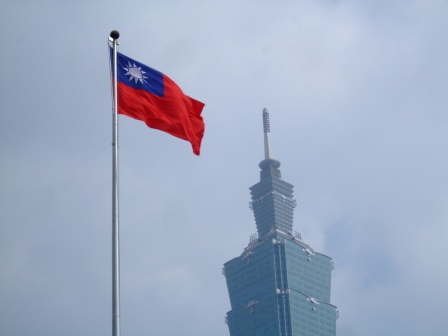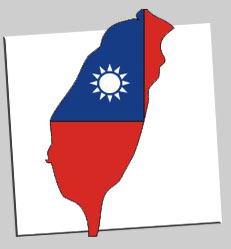In Chinese, the flag is commonly described as Blue Sky, White Sun, and a Wholly Red Earth (traditional Chinese: 青天, 白日, 滿地紅; simplified Chinese: 青天, 白日, 满地红; pinyin: Qīng Tiān, Bái Rì, Mǎn Dì Hóng) to reflect its attributes.
During the Wuchang Uprising in 1911 that heralded the Republic, the various revolutionary armies had different flags. Lu Hao-tung's "Clear Sky with a White Sun" flag was used in the provinces of Guangdong, Guangxi, Yunnan, and Guizhou. In Wuhan, a flag with 18 yellow stars was used to represent the 18 administrative divisions at the time. In Shanghai and northern China, a "Five-Colored Flag" (Chinese: 五色旗; pinyin: wǔ sè qí) (Five Races Under One Union flag) was used of five horizontal stripes representing the five major nationalities of China: the Han (red), the Manchu (yellow), the Mongol (blue), the Hui (white), and the Tibetan (black).
When the government of the Republic of China was established on January 1, 1912, the "Five-Colored Flag" was selected by the provisional Senate as the national flag. The "18-Star Flag" was adopted by the army and the modern flag was adopted as a naval ensign. Sun Yat-sen, however, did not consider the five-colored flag appropriate, reasoning that horizontal order implied a hierarchy or class like that which existed during dynastic times.
After President Yuan Shikai assumed dictatorial powers in 1913 by dissolving the National Assembly and outlawing the KMT, Sun Yat-sen established a government-in-exile in Tokyo and employed the modern flag as the national ROC flag. He continued using this design when the KMT established a rival government in Guangzhou in 1917. The modern flag was made the official national flag on December 17, 1928 after the successful Northern Expedition that toppled the Beijing government, though the Five-Colored Flag still continued to be used by locals in an unofficial capacity. One reason for this discrepancy in use was lingering regional biases held by officials and citizens of northern China, who favored the Five-Colored Flag, against southerners such as the Cantonese/Hakka Sun Yat-sen.[citation needed]
The flag was specified in Article Six of the 1947 Constitution. During World War II, the invading Japanese established a variety of puppet governments using several flag designs. The "Reform Government" established in March 1938 in Nanjing to consolidate the various puppet governments employed the Five-Colored Flag. When Wang Jingwei was slated to take over the Japanese-installed government in Nanjing in 1940, he demanded to use the modern flag as a means to challenge the authority of the Nationalist government in Chongqing under Chiang Kai-shek and position himself as the rightful successor to Sun Yat-sen. However, the Japanese preferred the Five-Colored flag. As a compromise, the Japanese suggested adding a triangular yellow pennant on top with the slogan "Peace, Anti-Communism, National Construction" (和平反共建國, Hépíng fǎn'gòng jiàn guó), but this was rejected by Wang. In the end, Wang and the Japanese agreed that the yellow banner was to be used outdoors only, until 1943 when the banner was abandoned, leaving two rival governments with the same flag, each claiming to be the legitimate Nationalist government of China.
After the Chinese Civil War in 1949, the government of Chiang Kai-shek relocated to the island of Taiwan and continued the Republic of China. On the mainland, the communist forces of Mao Zedong established the People's Republic of China and adopted their own national flag. On October 23, 1954, the National Emblem and National Flag of the Republic of China Act (Chinese: 中華民國國徽國旗法; pinyin: Zhōnghuá Mínguó guóhuī guóqífǎ) was promulgated by the Legislative Yuan to specify the size, measure, ratio, production, and management of the flag.
In the "Clear Sky with a White Sun" flag of Lu Hao-tung, the twelve rays of the white Sun symbolize the twelve months and the twelve traditional Chinese hours (時辰, shíchén), each of which corresponds to two modern hours (小時, xiǎoshí, literally: "little time"). Sun Yat-sen added the "Red Earth" to the flag to signify the blood of the revolutionaries who sacrificed themselves in order to overthrow the Qing Dynasty and create the ROC. Together, the three colors of flag correspond to the Three Principles of the People: Blue represents nationalism and liberty; White represents democracy and equality; and Red represents the people's livelihood and fraternity. The blue-and-white canton of the ROC flag is used as the party flag of the KMT. The flag has developed a great deal of additional symbolism due to the unique and controversial political status of Taiwan. At one level, the flag represents a clear symbol that Taiwan is not governed by the same government as Mainland China, as this flag is different from the flag of the People's Republic of China (PRC). Meanwhile, because it was formerly used as the flag over all of China, the flag has become a symbol of continuity with the ideals of the Chinese nationalism and Chinese reunification movements, and has become a symbol of a connection both historical and current with mainland China. In addition, the flag is derived from the seal of the KMT, and the color of the field of the flag is associated with the KMT party colors.
During the Wuchang Uprising in 1911 that heralded the Republic, the various revolutionary armies had different flags. Lu Hao-tung's "Clear Sky with a White Sun" flag was used in the provinces of Guangdong, Guangxi, Yunnan, and Guizhou. In Wuhan, a flag with 18 yellow stars was used to represent the 18 administrative divisions at the time. In Shanghai and northern China, a "Five-Colored Flag" (Chinese: 五色旗; pinyin: wǔ sè qí) (Five Races Under One Union flag) was used of five horizontal stripes representing the five major nationalities of China: the Han (red), the Manchu (yellow), the Mongol (blue), the Hui (white), and the Tibetan (black).
When the government of the Republic of China was established on January 1, 1912, the "Five-Colored Flag" was selected by the provisional Senate as the national flag. The "18-Star Flag" was adopted by the army and the modern flag was adopted as a naval ensign. Sun Yat-sen, however, did not consider the five-colored flag appropriate, reasoning that horizontal order implied a hierarchy or class like that which existed during dynastic times.
 Waving Flags-Part 1 |  ROC(Taiwan)-Flag.gif | .png) Chinese Taipei is the |  Taiwanese Flag |  Taipei (Taiwan), flag |
 8, 2008, in Taipei, Taiwan. |  8, 2008, in Taipei, Taiwan. |  Hall with Taiwanese Flag |  Taiwanese Flag, National Day Celebration - Taipei, Taiwan |  Taiwan Flag and Taipei 101 |
After the Chinese Civil War in 1949, the government of Chiang Kai-shek relocated to the island of Taiwan and continued the Republic of China. On the mainland, the communist forces of Mao Zedong established the People's Republic of China and adopted their own national flag. On October 23, 1954, the National Emblem and National Flag of the Republic of China Act (Chinese: 中華民國國徽國旗法; pinyin: Zhōnghuá Mínguó guóhuī guóqífǎ) was promulgated by the Legislative Yuan to specify the size, measure, ratio, production, and management of the flag.
 Taiwanese flag |  chinese-taipei-taiwan-flag |  Taiwan\x26#39;s flag. |  Taipei in Taiwan National Flag |  44 Taiwan Flag |
 taiwan-flag-sky-sun |  (Disputed) Flag will be used |  Taipei, Taiwan |  Taiwanese Flag - Taipei |  Taipei - Taiwan\x26#39;s visitor |
No comments:
Post a Comment